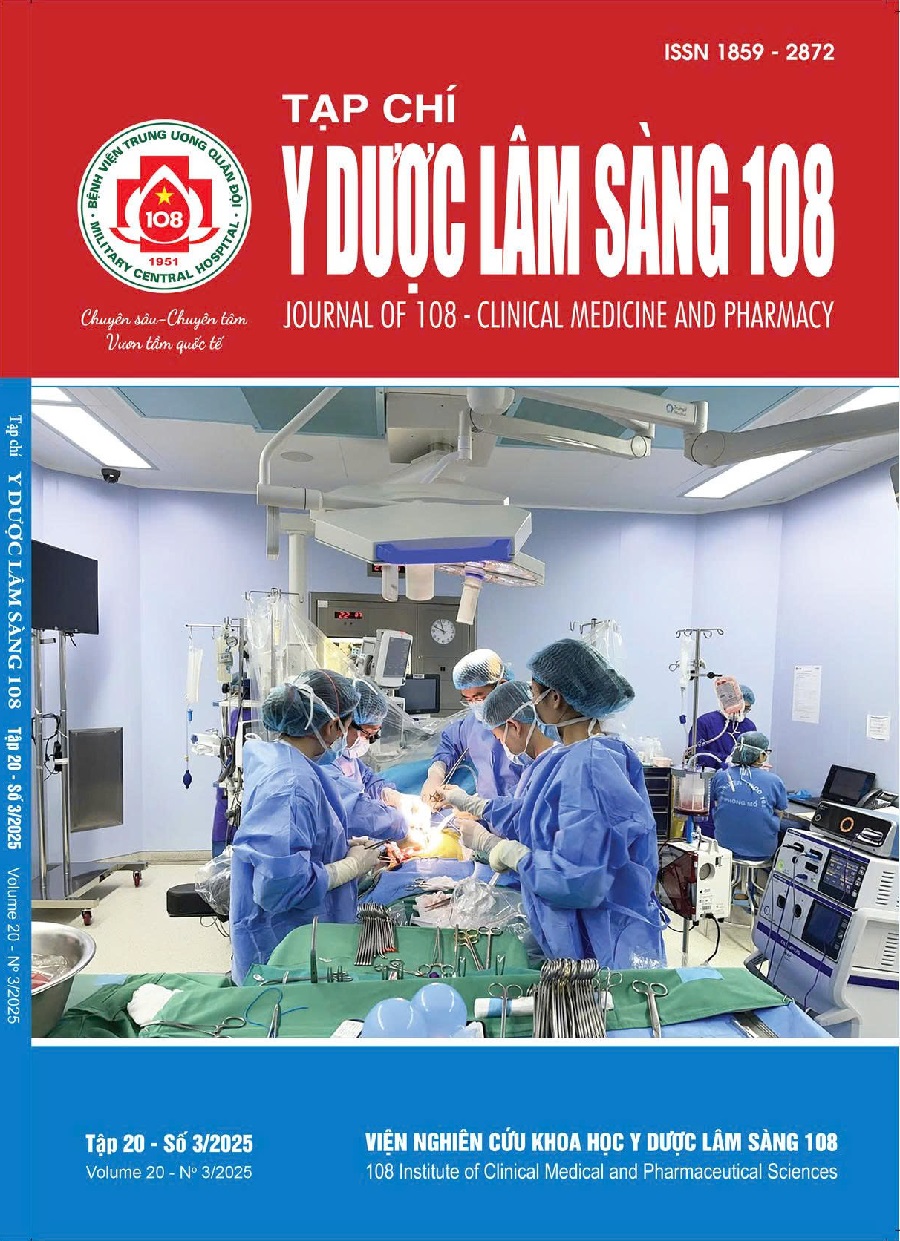Xây dựng mô hình dự đoán điều trị thay thế thận liên tục ở bệnh nhân sepsis
Main Article Content
Keywords
Tóm tắt
Mục tiêu: Xây dựng mô hình học máy bằng thuật toán XGBoost dự đoán điều trị thay thế thận liên tục (CRRT) ở bệnh nhân sepsis. Đối tượng và phương pháp: Nghiên cứu cắt ngang trên 530 bệnh nhân được chẩn đoán sepsis. Thu thập các chỉ số lâm sàng và cận lâm sàng tại thời điểm chẩn đoán. Theo dõi dọc thời gian xác định đối tượng có chỉ định CRRT. Chia cỡ mẫu thành 2 phần theo tỷ lệ 80:20. Trong đó, 80% cỡ mẫu huấn luyện mô hình bằng thuật toán XGBoost dựa trên các chỉ số lâm sàng và cận lâm sàng. 20% cỡ mẫu để đánh giá hiệu suất mô hình. Kết quả: Mô hình gồm 8 thông số gồm tuổi, giới, đường vào, nồng độ ure, creatinin, lactate và pH cho hiệu suất tối ưu với độ nhạy 92,3%, độ đặc hiệu 92,4%, độ chính xác tổng quát 91%, độ chính xác trong số dự đoán dương 85,7% và AUC rất tốt (0,95). Kết luận: Mô hình dựa trên thuật toán XGBoost có giá trị cao trong dự đoán CRRT ở bệnh nhân sepsis.
Article Details
Các tài liệu tham khảo
2. STARRT-AKI Investigators; Canadian Critical Care Trials Group; Australian and New Zealand Intensive Care Society Clinical Trials Group; United Kingdom Critical Care Research Group; Canadian Nephrology Trials Network; Irish Critical Care Trials Group; Bagshaw SM, Wald R, Adhikari NKJ et al (2020) Timing of Initiation of Renal-Replacement Therapy in Acute Kidney Injury. New England Journal of Medicine. 2020; 383(3): 240-251. doi:10.1056/NEJMoa2000741.
3. Uhel F, Peters-Sengers H, van der Poll T (2018) Initiation of renal replacement therapy in patients with sepsis: more to it than meets the eye. Ann Transl Med 6(2):S130. doi:10.21037/atm.2018.12.36.
4. Klein SJ, Brandtner AK, Lehner GF et al (2018) Biomarkers for prediction of renal replacement therapy in acute kidney injury: A systematic review and meta-analysis. Intensive Care Med 44(3): 323-336. doi:10.1007/s00134-018-5126-8.
5. Chen T, Guestrin C (2016) XGBoost: A Scalable Tree Boosting System. 6: 785-794.
6. Singer M, Deutschman CS, Seymour CW et al (2016) The third international consensus definitions for sepsis and septic shock (Sepsis-3). JAMA 315(8):801-810. doi:10.1001/jama.2016.0287.
7. Khwaja A (2012) KDIGO clinical practice guidelines for acute kidney injury. Nephron Clin Pract. 120(4): 179-184. doi:10.1159/000339789.
8. An JN, Kim SG, Song YR (2021) When and why to start continuous renal replacement therapy in critically ill patients with acute kidney injury. Kidney Res Clin Pract 40(4): 566-577. doi:10.23876/j.krcp.21.043.
9. Lameire N, Vanmassenhove J (2018) Timing of dialysis in sepsis and acute respiratory distress syndrome. Am J Respir Crit Care Med 198(1):4-5. doi:10.1164/rccm.201801-0129ED.
10. Ostermann M, Legrand M, Meersch M, Srisawat N, Zarbock A, Kellum JA (2024) Biomarkers in acute kidney injury. Annals of Intensive Care 14(1):145. doi: 10.1186/s13613-024-01360-9.
11. De Vlieger G, Koyner JL, Ostermann M (2025) Can we use artificial intelligence to better treat acute kidney injury? Intensive Care Med 51(1): 160-162. doi:10.1007/s00134-024-07743-7.
12. Meersch M, Weiss R, Gerss J et al (2023) Predicting the Development of Renal Replacement Therapy Indications by Combining the Furosemide Stress Test and Chemokine (C-C Motif) Ligand 14 in a Cohort of Postsurgical Patients. Crit Care Med 51(8): 1033-1042. doi:10.1097/ccm.0000000000005849.
13. Vanmassenhove J, Kielstein J, Jörres A, Biesen WV (2017) Management of patients at risk of acute kidney injury. Lancet 389(10084): 2139-2151. doi:10.1016/s0140-6736(17)31329-6.
14. Kellen M, Aronson S, Roizen MF, Barnard J, Thisted RA (1994) Predictive and diagnostic tests of renal failure: A review. Anesthesia & Analgesia 78(1):134-142.
15. Motzkus CA, Luckmann R (2017) Does infection site matter? A systematic review of infection site mortality in sepsis. Journal of intensive care medicine 32(8): 473-479.
16. Soni J, Sinha S, Pandey R (2024) Understanding bacterial pathogenicity: A closer look at the journey of harmful microbes. Frontiers in Microbiology 15:1370818.
17. Caraballo C, Jaimes F (2019) Organ dysfunction in sepsis: An ominous trajectory from infection to death. The Yale journal of biology and medicine 92(4): 629.
18. De Waele J, Lipman J, Sakr Y et al (2014) Abdominal infections in the intensive care unit: characteristics, treatment and determinants of outcome. BMC infectious diseases 14: 1-17.
19. Abe T, Tokuda Y, Shiraishi A et al (2019) In-hospital mortality associated with the misdiagnosis or unidentified site of infection at admission. Critical Care 23: 1-9.
20. Yue S, Li S, Huang X et al (2022) Machine learning for the prediction of acute kidney injury in patients with sepsis. Journal of Translational Medicine 20(1): 215. doi:10.1186/s12967-022-03364-0.
 ISSN: 1859 - 2872
ISSN: 1859 - 2872
